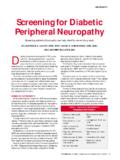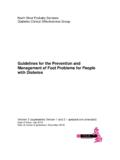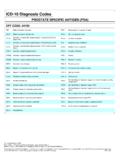Transcription of DIABETES MELLITUS. - Ophthalmic Imaging …
1 1 DIABETES Squirrell, SpR Ophthalmology Royal Hallamshire Hospital Bush General Practitioner and clinical assistant in is a huge subject, which occupies the working life of several thousand healthworkers in this country alone; to expect to cover it all in one module is thereforeunrealistic. The module has been designed to be all-inclusive, so although it is long,there should be no need to resort to any literature searches, unless of course you objectives for this module are that by the end of it you will be able to:SUnderstand normal glucose metabolism and homeostasisSExplain how this process goes wrong in diabetesSAppreciate the importance of DIABETES care to patients, the health care systemsand societySDescribe the classification of DIABETES and how it is diagnosedSUnderstand how DIABETES gives rise to microvascular and Discuss the treatment options, which are available in DEFINITION AND CLASSIFICATION OF DIABETES .
2 DIABETES mellitus is a disorder caused by the total (or relative) abscence of insulin,which manifests clinically as an elevated blood glucose. The classification of diabetesmellitus has been a major discussion point over the last few years. It has beenincreasingly recognised that the old classification system based upon a patients dependence on insulin was misleading; under the old system patients were eitherclassified as either Insulin Dependent DIABETES mellitus (IDDM) or Non Insulin2 Dependent DIABETES mellitus (NIDDM). In 1998, a new classification system basedupon the aetiological factors at work in DIABETES was proposed by the WHO and wehave listed it below: this has now become the accepted system for classifying diabetesmellitus (1).
3 Type 1 DIABETES : immune mediated and idiopathic forms of b cell dysfunction, whichlead to absolute insulin deficiency. This is an autoimmune mediated disease processwhich gives rise to absolute deficiency of insulin and therefore total dependancy uponinsulin for 2 DIABETES : disease of adult onset, which may originate from insulin resistanceand relative insulin deficiency or from a secretory defect. This is a disease, whichappears to have a very strong genetic predisposition and is caused by a combinationof inadequate insulin secretion and an insensitvity of the body tissues to insulin soleaving patients with this condition relatively deficient in 3 DIABETES : this covers a wide range of specific types of DIABETES includingvarious genetic defects in insulin action, and diseases of the exocrine 4 DIABETES is gestational EPIDEMIOLOGY OF prevalence of DIABETES of all types is approximately 3% in the UK.
4 It isestimated that there may be a further 2% of the population with undiagnosed relative prevalence of diabetic patients in the UK by classification is:3 Type1 DM25% of casesType 2DM70% of casesTypes 3&4 DM 5% of casesMorbidityDiabetes places a huge burden of illness on sufferers and society. People withdiabetes in the age group 45-64 years are 23 times more likely to be registered blindthan the non diabetic population of the same age. Diabetic retinopathy is the leadcause of blindness in this age group. DIABETES often affects the kidneys and up to 40%of people who develop Type 1 DIABETES before the age of 30 years can expect todevelop DIABETES related nephropathy. A significant number of these will progress torenal failure requiring long term renal dialysis treatment.
5 30% of people with diabetesdevelop diabetic neuropathy leading to a range of problems including from footulceration, sexual difficulties, cardiac arrhythmias and sudden is thought that 20 000 people per year die prematurely because of diabetesassociated disease. Most of these deaths are from the macrovascular complications ofdiabetes such as myocardial infarcts and cerebrovascular accidents. The number ofpeople dying prematurely in the diabetic population is double that of the non Features and AetiologyType 1 DIABETES typically presents in the teens with a short history of weight loss,incredible thirst and polyuria (passing lots of urine). Such patients are often thin, thereis very often no family history of DIABETES and although the cause of the illness is notknown, it is thought to be triggered by a viral 2 DIABETES typically presents later in life.
6 Such patients are often overweight atdiagnosis and there is often a strong family history of the disease. It is not knownwhy the disease develops but it may be related to over-eating. In contrast to type 1diabetes, patients with type 2 DIABETES are often asymptomatic when it is diagnosedand the diagnosis is often made whilst a doctor is investigating some other CARBOHYDRATE METABOLISMD iabetes mellitus is a condition characterized by defective insulin utilisation by thebody, which manifests itself as raised blood glucose. To understand DiabetesMellitus it is first essential to have an understanding of how the body normally dealswith glucose, which is the most important sugar in human metabolism.
7 You have beensupplied with a supplement, which briefly describes glucose homeostasis and inparticular the role and importance insulin within it. We suggest you read this now andwork through the questions in the supplement too. Once you have done so it may behelpful to write yourself a brief summary of the actions of insulin before you proceedwith the remainder of this module, as a thorough understanding of the role of insulin iskey to understanding DIAGNOSIS OF DIABETES MELLITUSD iagnosis and diagnostic testsThe body usually is able to keep glucose concentrations stable. The normal fastingblood sugar is usually between After a meal it would rarely exceed58mmol/l. Normally there is no glucose in urine since the normal threshold abovewhich glucose would appear in the urine would be 10mmol/l.
8 Below a concentrationof 10mmol/l the kidneys reabsorbs glucose back into the blood stream and so glucosedoes not appear in the urine unless the blood concentration of glucose is high. Dip-sticking urine for the presence of glucose is therefore often used as a screening test fordiabetes diagnosis of DIABETES mellitus is made by finding a fasting blood glucose of or a random glucose of >10mmol/l. If a patient presents with symptoms ofdiabetes and is found to have a single very high glucose measurement eg >15mmol/lthen this can be diagnostic. More commonly it would be appropriate to ask thepatient to fast overnight and attend for a fasting blood glucose to be taken the nextmorning.
9 Ideally this should be performed on two occasions before there is any doubt about the diagnosis then a further test can be performed. Thistest is called the oral glucose tolerance test and it measures how the body responds toa glucose load. The patient is asked to fast overnight and then attends for the patient has a blood glucose level taken and is then given a drink, which contains75gm of glucose. After two hours another blood sample is taken. From the results ofthe glucose tolerance test the patient can be either diagnosed as having DIABETES ,impaired glucose tolerance or no abnormality of glucose for you move on be sure you can answer the following questions:1.
10 What is DIABETES mellitus ?2. According to the new classification, what are the two commonest types of diabetesmellitus in the UK?3. A 14 year old by is taken by his mother to the doctor with a 2 week history ofbeing unwell, loosing weight and drinking pints and pints of water. He also admits6to going to the loo very frequently. He is found to have glucose in his urine and theblood glucose is also high. The doctor diagnoses DIABETES . Based on the newclassification, which type of DIABETES do you think he has?4. A 70 year old man attends his eye casualty with a sixth nerve palsy. The gentlemanhimself is overweight but otherwise proclaims himself fit and well. Urine dipsticksuggests DIABETES , which is confirmed by a blood test.








